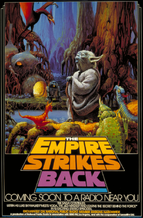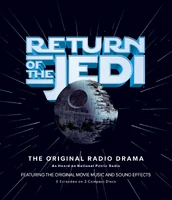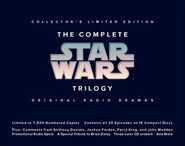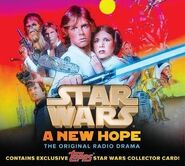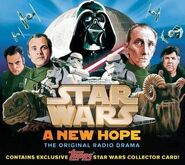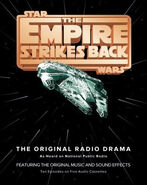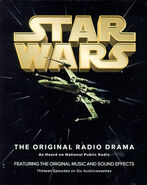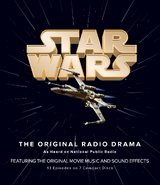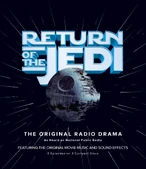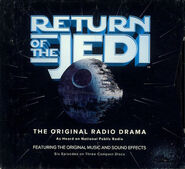- "A long time ago, in a galaxy far, far away... there came a time of revolution, when rebels united to challenge a tyrannical empire."
- ―Ken Hiller's introduction to each radio episode
An expanded radio dramatization of the original Star Wars trilogy was produced in 1981, 1983, and 1996. The first two radio series, based on Star Wars and The Empire Strikes Back, were produced and broadcast by National Public Radio as part of NPR Playhouse. A dramatization of Return of the Jedi was produced by HighBridge Audio; it involved most of the same team and was broadcast by NPR's L.A. Theatre Works.
The radio serials were made with the full co-operation of George Lucas, who for one dollar each sold the rights to KUSC-FM, the public radio affiliate at his alma mater, the University of Southern California. The deal allowed the production team full use of the films' sound effects and musical score. Recordings of all three dramatizations were produced by HighBridge, and Del Rey published the three scripts in book form.
Star Wars[]
Star Wars is a 13-part, 6½-hour radio serial based on Star Wars: Episode IV A New Hope. It was first broadcast on National Public Radio in 1981. Brian Daley wrote the script, John Madden directed the voice actors, and Tom Voegeli led the sound mixing in post-production, combining the recorded performance with the original film's music by John Williams and sound effects by Ben Burtt. NPR went to considerable effort to promote the drama, commissioning a poster, hosting an opening gala at Griffith Observatory in Los Angeles, and producing a making-of documentary, A Fable for the Mind's Eye.
The series fleshes out the storyline by adding a great deal of backstory, some of which was taken from deleted scenes from the film. One episode depicts Princess Leia's first encounter with Darth Vader; another shows how her ship obtains the Death Star plans after the Battle of Toprawa. Luke Skywalker's first episode depicts his life on Tatooine, including a skyhopper race in Beggar's Canyon—something alluded to in the film but never shown—and later his witnessing of the movie's opening battle through his macrobinoculars, which comes from a deleted scene. Later additional scenes depict Threepio and Artoo's efforts to evade capture in the streets of Mos Eisley, Luke's lightsaber combat training aboard ship, and Leia's brutal psychological torture at Vader's hands, among other additions.
The episodes were entitled:
- "A Wind to Shake the Stars"
- "Points of Origin
- "Black Knight, White Princess, and Pawns"
- "While Giants Mark Time"
- "Jedi that Was, Jedi to Be"
- "The Millennium Falcon Deal"
- "The Han Solo Solution"
- "Death Star's Transit"
- "Rogues, Rebels and Robots"
- "The Luke Skywalker Initiative"
- "The Jedi Nexus"
- "The Case for Rebellion"
- "Force and Counterforce"
Cast[]
Many of the actors involved in the movie were unavailable to reprise their roles: Harrison Ford, for instance, was committed to the first Indiana Jones movie. Two of the actors, Mark Hamill and Anthony Daniels, returned to reprise their roles as Luke Skywalker and C-3PO respectively.
- Mark Hamill, Luke Skywalker
- Ann Sachs, Princess Leia Organa
- Perry King, Han Solo
- Bernard "Bunny" Behrens, Obi-Wan Kenobi
- Brock Peters, Lord Darth Vader
- Anthony Daniels, C-3PO
- Keene Curtis, Grand Moff Tarkin
- John Considine, Lord Tion
- Stephen Elliott, Prestor – more widely known as Bail Organa
- David Ackroyd, Captain Antilles
- Adam Arkin, Fixer
- Kale Browne, Biggs Darklighter
- David Clennon, Motti
- Anne Gerety, Aunt Beru
- Thomas Hill, Uncle Owen
- David Paymer, Deak
- Joel Brooks, Heater
- John Dukakis, Rebel
- Stephanie Steele, Cammie
- Phillip Kellard, Customer #2
The supporting cast included James Blendick, Clyde Burton, Bruce French, David Alan Grier, Jerry Hardin, John Harkins, Meshach Taylor, Marc Vahanian, John Welsh, and Kent Williams.
The Empire Strikes Back[]
The success of the first series led to a 10-part, five-hour series based on Star Wars: Episode V The Empire Strikes Back, which debuted on NPR on February 14, 1983. The three principal production leaders, Daley, Madden, and Voegli, returned, with Voegli getting an additional credit as co-director. All the principal cast members also reprised their roles. As with the first Star Wars radio drama, NPR launched an extensive promotional campaign. In one unusual promotion, Craig Claiborne was tapped to create a version of Yoda's rootleaf stew recipe, which the Jedi Master served Luke in his hut on Dagobah. The recipe ran in magazines and newspapers across the country.
Like Star Wars, The Empire Strikes Back expanded on the film's story, incorporating new scenes to flesh out characters and events, though its shorter ten-episode run meant that such additions could not be as long. The first episode begins before the film's opening scene and features an Imperial attack on a Rebel patrol in the Battle of Derra IV, followed by depictions of the Rebels' work to establish their hidden base. A later scene shows Han Solo's efforts to keep Luke Skywalker alive while stranded overnight in an emergency shelter in the frozen wastelands of Hoth. Still later, the cyborg Lobot, mute for the entirety of the film, is given a few terse lines of dialogue.
The Empire Strikes Back
The episodes were titled:
Cast[]
Billy Dee Williams reprised Lando Calrissian, and John Lithgow played Yoda; at the time Madden was directing Lithgow in the play Beyond Therapy.
- Mark Hamill (Luke Skywalker)
- Ann Sachs (Princess Leia)
- Perry King (Han Solo)
- Billy Dee Williams (Lando Calrissian)
- Bernard "Bunny" Behrens (Obi-Wan Kenobi)
- Brock Peters (Lord Darth Vader)
- John Lithgow (Yoda)
- Anthony Daniels (C-3PO)
- James Eckhouse (Beta)
- Peter Friedman (Dak)
- Ron Frazier (Deck Officer)
- Merwin Goldsmith (General Rieekan)
- Peter Michael Goetz (Ozzel)
- Gordon Gould (Veers)
- Paul Hecht (The Emperor)
- Russell Horton (2-1B)
- James Hurdle (Controller)
- Nicholas Kepros (Needa)
- David Rasche (Piett)
- Alan Rosenberg (Boba Fett)
- Don Scardino (Wedge)
- Ken Hiller (Narrator)
The supporting cast again included David Alan Grier and also included Sam McMurray, Steven Markle, Stephen D. Newman, John Pielmeier, Geoffrey Pierson, Gary Tacon, and Jerry Zaks.
Return of the Jedi[]
NPR's plans for a third radio serial based on Star Wars: Episode VI Return of the Jedi were put on hold when federal funding for public radio was dramatically reduced during the administration of Ronald Reagan. In 1996 HighBridge Audio, the company that had released the first two series on tape and CD, finally undertook the production of the third installment of the trilogy. Return of the Jedi was written in six episodes for a running time of about three hours. The core production team of Daley, Madden and Voegli reassembled, as did most of the principal cast members, though notably not Mark Hamill or Billy Dee Williams, whose roles had to be recast. Scriptwriter Brian Daley was ill with cancer during production and in fact died on the day that recording concluded; therefore John Whitman was hired to handle necessary rewrites and additions that would be identified by the director and cast. However, in most cases Madden accepted Daley's script without changes, and Whitman is credited as an additional writer only for the first two episodes.[3]
Despite its much shorter running time than the two preceding series, Return of the Jedi followed them in adding additional scenes and dialogue to the story. Many of these drew connections to the growing Star Wars Expanded Universe, making references to events from the Thrawn Trilogy, Dark Empire, and Shadows of the Empire, the last of which was published a few months before the radio drama's premier. The opening scene, depicting Luke Skywalker's construction of his new lightsaber, follows directly on the epilogue of Shadows of the Empire.[4] Another scene depicts a conversation between C-3PO and Thrawn Trilogy character Mara Jade, who is undercover in the palace of Jabba the Hutt.
The episodes were titled:
Cast[]
The adaptation used many of the original radio cast, though Joshua Fardon took over as Luke and Arye Gross replaced Billy Dee Williams as Lando. Ed Begley, Jr. was the voice of Boba Fett and Ed Asner, speaking only in grunts, guest-stars as Jabba the Hutt. The only actor who starred in both the feature films and all three radio dramas was Anthony Daniels.
- Joshua Fardon (Luke Skywalker)
- Perry King (Han Solo)
- Ann Sachs (Princess Leia Organa)
- Anthony Daniels (C-3PO)
- Bernard Behrens (Obi-Wan Kenobi)
- Arye Gross (Lando Calrissian)
- Edward Asner (Jabba The Hutt)
- Paul Hecht (The Emperor)
- John Lithgow (Yoda)
- Brock Peters (Lord Darth Vader)
- Ed Begley, Jr. (Boba Fett)
- Samantha Bennett (Arica)
- David Birney (Anakin Skywalker)
- Peter Dennis (Moff Jerjerrod)
- David Dukes (Bib Fortuna)
- Peter Michael Goetz (General Madine)
- Ian Gomez (Salacious Crumb)
- Martin Jarvis (Barada)
- Jon Matthews (Wedge)
- Natalija Nogulich (Mon Mothma)
- Mark Adair Rios (Admiral Gial Ackbar)
- Yeardley Smith (9D9)
- Tom Virtue (Major Derlin)
- Ken Hiller (Narrator)
The supporting cast included Rick Hall, Andrew Hawkes, Sherman Howard, Karl Johnson, John Kapelos, Ron Le Paz, Joe Liss, Paul Mercier, Steven Petrarca, Jonathan Penner, Gil Segel, Nia Vardalos and Ron West.
Other broadcasts and releases[]
- There are several radio promos, deleted scenes, and additional music tracks available that originated on previous releases of this collection and in the NPR broadcast versions.
- BBC Radio 1 broadcast the series in the UK, with a key scene in the final episode clumsily cut for timing.
- All three series have been released on cassette tape and CD.
The tracks are:
- "Radio Promo #1 - Anthony Daniels"
- "Radio Promo #2 - Ann Sachs"
- "Radio Promo #3 - Mark Hamill"
- "Star Wars Radio Drama - Additional Music"
- "Star Wars Radio Drama - Alternate Take 'Your Father's Lightsaber'"
- "Star Wars Radio Drama - Alternate Take 'Bail and Leia'"
- "Return Of The Jedi Radio Drama - Alternate Take 'Speederbike Chase'"
- "The Making Of The Radio Dramas"
Canonicity and continuity[]
The earliest statements about Star Wars canon, made in 1994 in A Guide to the Star Wars Universe and Star Wars Insider 23, gave a privileged status to the radio dramas and novelizations alongside the films, considering them all to be official benchmarks for what was in the Star Wars universe.[5][6] In 2000, Lucasfilm reorganized the canon and specified that the highest level, "G-canon," was reserved the films only.[7][8] Since then, anything in the radio dramas beyond the events of the films has been part of the Expanded Universe, which became Star Wars Legends in 2014.
Media[]
Editions[]
- ISBN 9781622313242; November 6, 2013; High Bridge Audio; Collector's Edition: Light Side[2]
- ISBN 9781622313259; November 6, 2013; High Bridge Audio; Collector's Edition: Dark Side[9]
Cover gallery[]
Sources[]
Notes and references[]
- ↑ 1.00 1.01 1.02 1.03 1.04 1.05 1.06 1.07 1.08 1.09 1.10 1.11 1.12 1.13 1.14 Star Wars radio drama
- ↑ 2.0 2.1 2.2
 Star Wars: A New Hope Topps Collector's Edition: Light Side radio drama on HighBridge Audio's official website (backup link)
Star Wars: A New Hope Topps Collector's Edition: Light Side radio drama on HighBridge Audio's official website (backup link)
- ↑ Return of the Jedi: The National Public Radio Dramatization
- ↑ Shadows of the Empire
- ↑ A Guide to the Star Wars Universe
- ↑ Star Wars Insider 23
- ↑
 "What'd I say again? Select posts by me regarding continuity" — Keeper of the Holocron's Blog — Leland Chee's StarWars.com Blog (backup link)
"What'd I say again? Select posts by me regarding continuity" — Keeper of the Holocron's Blog — Leland Chee's StarWars.com Blog (backup link)
- ↑
 Ask the Lucasfilm Jedi Council, April 24, 2000 on StarWars.com (content now obsolete; backup link)
Ask the Lucasfilm Jedi Council, April 24, 2000 on StarWars.com (content now obsolete; backup link)
- ↑
 Star Wars: A New Hope Topps Collector's Edition: Dark Side radio drama on HighBridge Audio's official website (backup link)
Star Wars: A New Hope Topps Collector's Edition: Dark Side radio drama on HighBridge Audio's official website (backup link)
External links[]
 Star Wars radio drama on HighBridge Audio's official website (backup link)
Star Wars radio drama on HighBridge Audio's official website (backup link) Star Wars: A New Hope Topps Collector's Edition: Light Side radio drama on HighBridge Audio's official website (backup link)
Star Wars: A New Hope Topps Collector's Edition: Light Side radio drama on HighBridge Audio's official website (backup link) Star Wars: A New Hope Topps Collector's Edition: Dark Side radio drama on HighBridge Audio's official website (backup link)
Star Wars: A New Hope Topps Collector's Edition: Dark Side radio drama on HighBridge Audio's official website (backup link) The Empire Strikes Back radio drama on HighBridge Audio's official website (backup link)
The Empire Strikes Back radio drama on HighBridge Audio's official website (backup link) Return of the Jedi radio drama on HighBridge Audio's official website (backup link)
Return of the Jedi radio drama on HighBridge Audio's official website (backup link)


